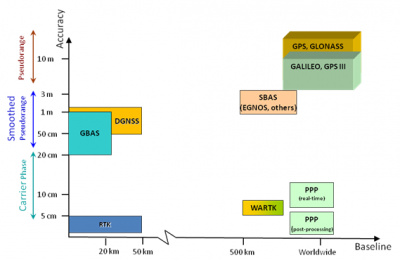If you wish to contribute or participate in the discussions about articles you are invited to contact the Editor
Ground-Based Augmentation System (GBAS)
| Fundamentals | |
|---|---|
| Title | Ground-Based Augmentation System (GBAS) |
| Author(s) | GMV |
| Level | Basic |
| Year of Publication | 2011 |
Augmentation of a global navigation satellite system (GNSS) is a method of improving – “augmenting” - the navigation system's performances, such as integrity, continuity, accuracy or availability thanks to the use of external information to the GNSS into the user position solution[1][2].
Introduction
Based on its main feature, GNSS augmentation systems can be classified as those providing integrity information to the primary GNSS satellites constellation(s) and those improving the accuracy of the user solution with respect to the only use of the primary GNSS constellation(s). A further classification may be done according to an additional relevant feature, which for the former relates on whether the augmentation information comes from satellites (satellite-based augmentation system) or from ground (ground-based augmentation system) and for the latter on whether the accuracy improvements use a dense network of reference stations (Differential GNSS, Real Time Kinematic - RTK - or Wide Area RTK) or just a few stations (Precise Point Positioning - PPP) for the computation of the augmentation information.
Ground-based Augmentation Systems
A Ground-Based Augmentation System (GBAS) is a civil-aviation safety-critical system that supports local augmentation – at airport level – of the primary GNSS constellation(s) by providing enhanced levels of service that support all phases of approach, landing, departure and surface operations. While the main goal of GBAS is to provide integrity assurance, it also increases the accuracy with position errors below 1 m (1 sigma).
The ground infrastructure includes two or more GNSS receivers which collect pseudoranges for all the primary GNSS satellites in view and computes and broadcasts differential corrections and integrity-related information for them based on its own surveyed position. These differential corrections are transmitted from the ground system via a Very High Frequency (VHF) Data Broadcast (VDB). The broadcast information includes pseudorange corrections, integrity parameters and various locally relevant data such as Final Approach Segment (FAS) data, referenced to the World Geodetic System (WGS-84).
The aircraft within the area of coverage of the ground station may use the broadcast corrections to compute their own measurements in line with the differential principle. The differentially corrected position is used to generate navigation guidance signals.
Notes
References
- ^ Wikipedia:GNSS augmentation
- ^ E.D. Kaplan, C.J. Hegarty, Understanding GPS Principles and Applications”, 2nd Ed., Artch House, ISBN 1-58053-894-0, 2006.

